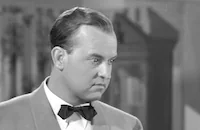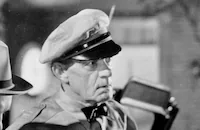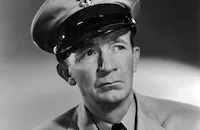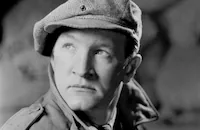The Man on the Flying Trapeze
Brief Synopsis
Cast & Crew
Clyde Bruckman
W. C. Fields
Mary Brian
Kathleen Howard
Lucien Littlefield
Vera Lewis
Film Details
Technical Specs

Synopsis
For eight years, browbeaten drunk Ambrose Wolfinger has supported his second wife Leona's priggish mother, Cordelia Neselrode, and her loafer brother Claude, while his own daughter Hope continues to work. When, in the middle of the night, two sentimental burglars get drunk in the cellar on Ambrose's homemade applejack, Ambrose and a policeman join them in song. Ambrose reluctantly turns the burglars in, only to have them released when the judge arrests him for manufacturing liquor without a license. Ambrose, who is a memory expert for the absent-minded president of Malloy Mfg. Co., then gets the afternoon off for the world's heavyweight wrestling championship by lying to his boss about the death of his mother-in-law from poison liquor. Malloy's assistant, Mr. Peabody, then alerts the press, and Ambrose's loyal co-workers send flowers and condolences en masse to the Wolfingers' home, where Cordelia reads her own shameful obituary with horror. On his way to the match, Ambrose is harassed by numerous policemen and arrives just as the last ticket is sold, while inside Claude enjoys the front row seat he stole from Ambrose. When the Russian wrestler Tosoff is thrown from the ring, he lands on top of Ambrose, who falls unconscious on the street. Ambrose's secretary, who is also attending the match, comes to his aid, after which Claude publicly accuses him of being drunk in the gutter with his secretary, and Peabody fires him. At home, Ambrose defends himself against Claude's accusation and knocks him out when he insults Hope, causing Leona to kick him out of his own home. After Malloy learns Peabody fired Ambrose, he orders him to get him back, and Hope, receiving Peabody's phone call, secures Ambrose a substantial raise and a long vacation. Leona then has a change of heart and, insisting Claude go to work, defies her mother's disdain for Ambrose and goes back to him. While the Wolfingers ride in Ambrose's new car in the rain, Cordelia and Claude get soaked in the rumble seat.

Director
Clyde Bruckman
Cast

W. C. Fields

Mary Brian
Kathleen Howard

Lucien Littlefield
Vera Lewis
Oscar Apfel

Grady Sutton

Lew Kelly
Tammany Young

Walter Brennan
Edward Gargan

James Burke
Carlotte Monti
Arthur Aylesworth
Harry Ekezian
Tor Johnson
David Clyde
Dorothy Thompson
Lorin Raker
Pat O'malley
Sarah Edwards

James Flavin
Robert Littlefield
Michael S. Visaroff
Charles Morris
Eddie Sturgis
Eddie Chandler

Joseph Sauers
Mickey Mcmasters
Keith Daniels
Sam Lufkin
Billy Bletcher
Helen Dickson
Albert Taylor
Jack Baxley
George French
Harry C. Bradley
Rosemary Theby
Crew
Charles Bogle
Jack Cunningham
Richard Currier
Hans Dreier
Paul Dresser
Alfred Gilks
Frank Griffen
Sam Hardy
Sam Hardy
Ray Harris
Earl Hedrick
Henry Herzbrun
William Lebaron
Johnny W. Sinclair
Bobby Vernon
Adolph Zukor

Film Details
Technical Specs

Articles
The Man on the Flying Trapeze
The Man on the Flying Trapeze was to some degree a remake of a previous Fields film, the 1927 feature Running Wild. However, as usual with Fields, the end result doesn't have much resemblance to the original, partly due to Fields' usual technique of extensive ad-libbing. Fields also brought in as a writing partner Sam Hardy, a buddy from his Ziegfeld Follies days. Together they reworked the material and according to one report the two even directed much of the film when the actual director (Clyde Bruckman of The Fatal Glass of Beer, 1933) became ill during production.
But it was still a difficult shoot. For one thing, the studio heads hired their own writers to revise portions and dialogue in the script and then went to battle with Fields over the casting. Eventually Fields won part of that battle only to sprain an ankle and fall victim to some illness himself during filming. (As soon as the movie was finished, Fields went into a health spa in an attempt to cure his ailments.)
The comedian did get to put some of his favorite actors into the cast. Mary Brian, for instance, reprised her role as his daughter from Running Wild while Fields' companion Carlotta Monti made a small appearance. (Years later, Monti would write a book about their relationship.) Other interesting cast members include Kathleen Howard (as the wife) who was a former opera singer from the Metropolitan Opera while Tor Johnson was a real-life Swedish wrestler who later appeared in three Ed Wood films, including Plan 9 from Outer Space (1958).
Producer: William LeBaron
Director: Clyde Bruckman
Screenplay: Jack Cunningham, W.C. Fields (story) (as Charles Bogle), Sam Hardy (story), Ray Harris, Bobby Vernon
Cinematography: Alfred Gilks
Film Editing: Richard C. Currier
Original Music: Tom Satterfield
Cast: W.C. Fields (Ambrose Wolfinger), Mary Brian (Hope Wolfinger), Kathleen Howard (Leona Wolfinger), Vera Lewis (Mrs. Cordelia Neselrode), Grady Sutton (Claude Neselrode).
BW-65m.
by Lang Thompson

The Man on the Flying Trapeze
Quotes
Trivia
Mr Wolfinger's secretary is played by 'W. C. Fields' ' real life mistress, Carlotta Monti.
Notes
On 30 April 1935, Daily Variety reported that an untitled W. C. Fields Paramount film had begun shooting, probably referring to this film. On June 12, 1935, Hollywood Reporter announced that Fields had persuaded Paramount to call the film The Man on the Flying Trapeze, after Paramount had rejected that title in favor of Everything Happens at Once. According to Hollywood Reporter, Fields also convinced Paramount to credit Sam Hardy as co-author of the film, along with Charles Bogle (a pseudonym for W. C. Fields).
The song "On the Banks of the Wabash," originally copyrighted in 1897, was revived by Freddy Martin in the 1930s. Although Variety called this film "just a series of unrelated gags...a lightweight, a misnomer and a weakie," New York Times said the film's comedy contains "the kind of burlesque which comes dangerously close to realism." Several contemporary reviews asserted that Fields was the only selling point in the film's exploitation. Many reviews also commented on the seemingly "non sequitur" title of the film, one speculating that the filmmakers were trying to capitalize on the resurgence in 1933 of the popular anonymous song "The Man on the Flying Trapeze," which was copyrighted in 1868 under the title "The Flying Trapeze." Motion Picture Herald, however, justifies the title by describing Fields's character as a "hero on a continual mental and circumstantial flying trapeze."
According to modern sources, one of the film's working titles was The Memory Expert, under which title the film was released in Europe. Modern sources comment on the autobiographical nature of the film, noting that many of the details of the story echo aspects of Fields's private and professional life. Grady Sutton, quoted in a modern source, states that Fields generally ad-libbed ad infinitum on the set. Sutton remembers one instance when Fields, after rambling on-camera, pulled Sutton aside and said, "Now look, son, we'll work it this way. When you think I've said enough, well you just butt in." As reported in a modern source, following the completion of the film's shooting in late May 1935, Fields became seriously ill, causing the Hollywood press to speculate that this would be his last film. Although on June 18, 1935, Hollywood Reporter stated that Fields was confined to his home with two nurses in twenty-four hour attendance, because of an attack of the flu and a wrenched ankle, a modern source indicates that Fields was sick from alcoholism.
The following additional cast members are listed in a modern source: Heinie Conklin (Street cleaner), Minerva Urecal (Italian woman in ambulance) and Mickey Bennett (Office employee). Mary Brian also played Fields's daughter in the 1927 Paramount films Two Flaming Youths and Running Wild, which has a similar plot to this film (see AFI Catalog of Feature Films, 1921-30; F2.4737 and F2.5909).














